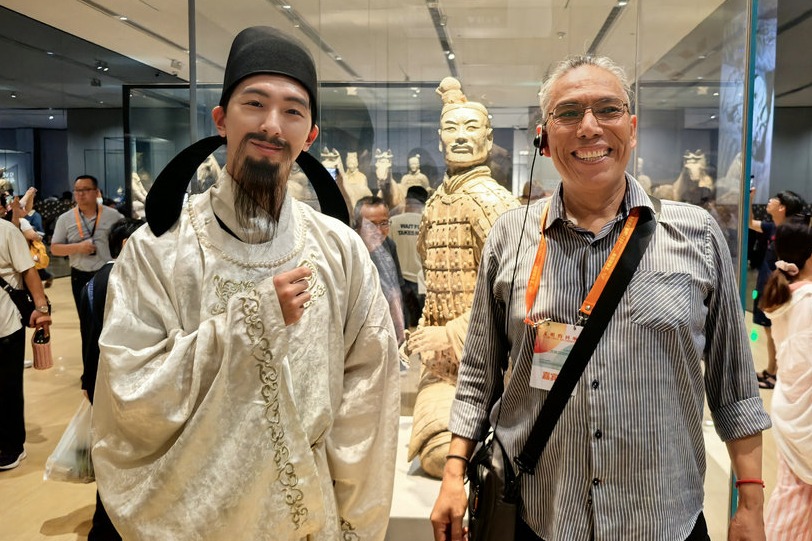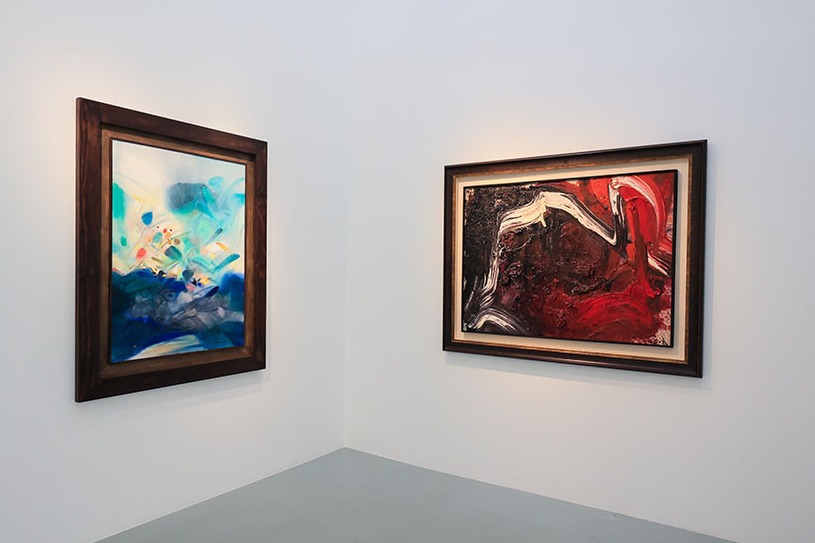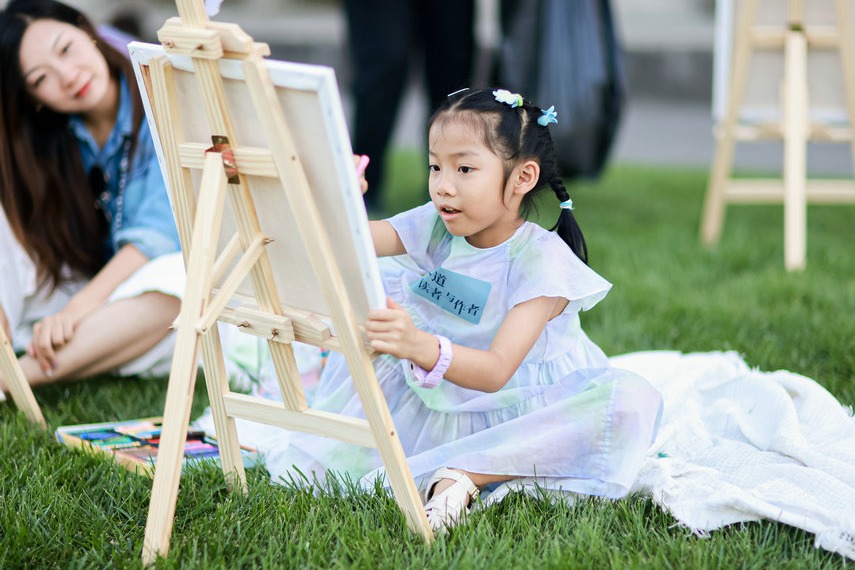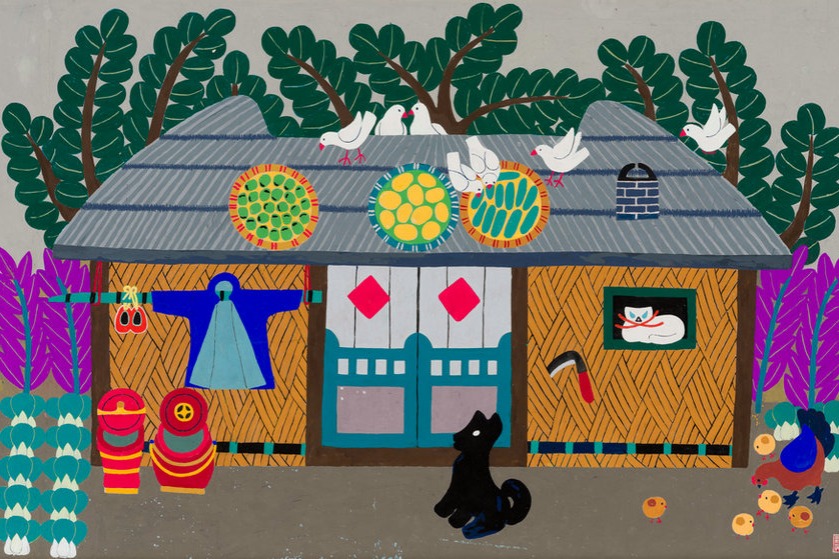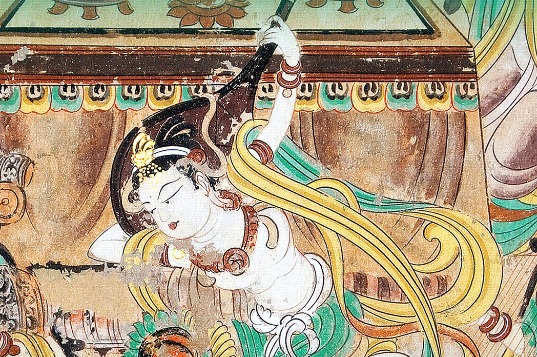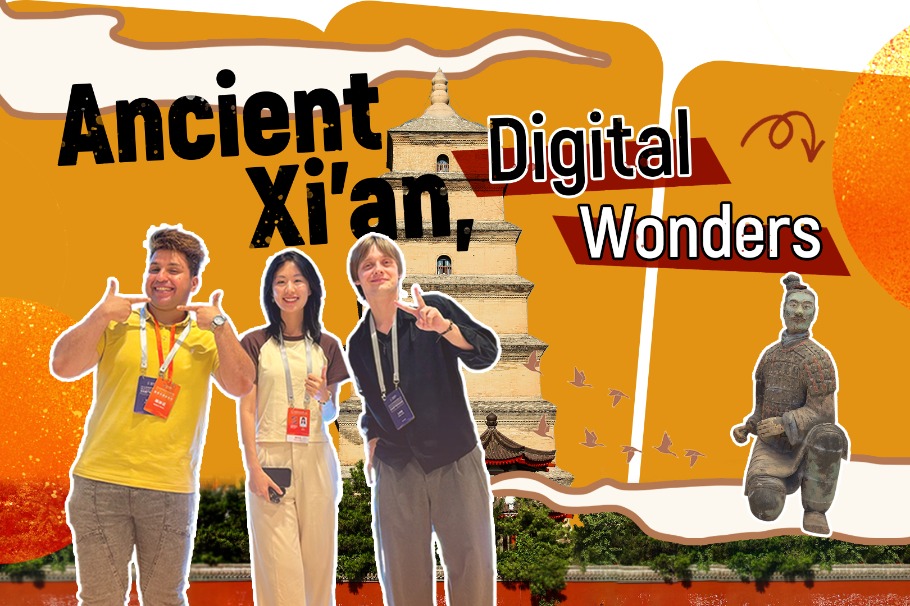Multidimensional programs turn history into experience

 YANG LIU/CHINA DAILY/LI YUMENG/FOR CHINA DAILY
YANG LIU/CHINA DAILY/LI YUMENG/FOR CHINA DAILY
This summer, the Mingsha Mountain and Crescent Spring scenic spot in Dunhuang in Northwest China's Gansu province gained widespread attention from tourists due to its starry night views. As night fell, a concert began. Tourists gathered on the towering dunes, singing heartily along to the music. Some turned on their phone flashlights, which shimmered in harmony with the night sky. The collective singing pierced through the darkness romantically, accompanied by a heart-warming light show.
City brands
The Mingsha Mountain and Crescent Spring scenic sites have been renowned far and wide for more than 1,000 years. Mingsha Mountain, featuring rugged ridges, has a base composed of gravel topped with fine sand in five colors — red, yellow, green, black and white — blending into a brilliant spectrum.
Remarkably, the sand here "can sing". It is speculated that the mountain emits enchanting sounds due to the mica in the sand grains or the friction and resonance of pitted particles. This phenomenon is also the origin of the name Mingsha Mountain, which means "singing sand mountain" in Chinese. The natural topography of the Mingsha Mountain provided the concert with exceptional acoustic effects.
The Crescent Spring, nestled within Mingsha Mountain, derives its name from its resemblance to a crescent moon. Although located in the desert and surrounded by sand dunes, the spring has never been buried by shifting sands nor dried up through evaporation over thousands of years.
Currently, the Dunhuang city government is using its rich tourism resources to advance the "two cities and two hubs" plan, positioning Dunhuang as a city of culture, a city of art and a hub for cultural creativity and exhibitions.
The Mingsha Mountain and Crescent Spring scenic spot now covers 76.82 square kilometers and is recognized as a national 5A-level tourist attraction. There is also a slope known as the "fairy slope". Visitors there dress as feitian — the flying apsaras depicted in Dunhuang murals — or as princesses from Western countries and dance to the sound of camel bells, while photographers capture these enchanting moments.
The Dunhuang Press and the Dunhuang Book Center stand as key cultural landmarks. They offer a quiet and homely atmosphere, inviting visitors to explore their collections and read in peace. Nearly 10,000 types of cultural and creative products have been sold here, bringing Dunhuang's profound history to life for a modern audience.
The Dunhuang International Convention and Exhibition Center, Dunhuang Theater and Dunhuang International Hotel form a cluster of infrastructure supporting the local exhibition economy. The Silk Road (Dunhuang) International Cultural Expo, which has attracted participants from around the world, has become another key platform for cultural exchange.
Guardians of culture
Preserving cultural roots remain a commitment of the Dunhuang people. The history of the Mogao Caves in Dunhuang dates back approximately 1,600 years. Since then, artisans from successive dynasties have spent over a millennium carving there. These caves feature fluttering ribbons and flying apsaras, the well-known nine-colored deer, exquisite paintings of the Qianshou Guanyin (Thousand-Hand Bodhisattva), valuable historical records on Dunhuang manuscripts and diverse painted sculptures with distinctive expressions from different dynasties.
The millennium-old cultural treasure trove of ancient art is now digitally preserved. As an effective measure to protect the Mogao Caves, a digital library was launched for a worldwide audience, making more than 6,500 digital archives from the Mogao Caves, other cave sites, and the Dunhuang Library Cave available globally.
With just a click, people can browse ultrahigh-resolution images of the caves. The platform has attracted visitors from 78 countries, generating more than 23 million visits.
Relying on the digital caves, users can engage in role-playing through different eras, interact with historical figures and witness the evolution of the caves from the late Tang Dynasty (618-907) to the end of the Qing Dynasty (1644-1911).
The Dunhuang Academy, a national institution for the conservation, management, and research of the Mogao Caves, launched a digital immersive exhibition in 2023 in collaboration with tech giant Tencent to help bring the stories of Dunhuang to the public. Users wearing virtual reality glasses can view the murals and details of Cave 285 up close. Using the VR device, they can also "fly" to the ceiling, immerse themselves in the storyline of the murals, and experience the charm of Dunhuang culture.
Art reinterpretation
The reinterpretation of culture is another driving force behind the development of the tourism experience. Drawing on historical themes, contemporary artists have created awe-inspiring masterpieces.
The classic dance drama Flower Rains Along Silk Road, based on Dunhuang murals and the ancient Silk Road, features images such as a flying apsara playing the pipa lute with a reversed hand. It has been performed in more than 40 countries and regions. Hailed as a "model of Chinese ethnic dance drama", the performance has become a symbol of cultural exchanges with the world.
The dance drama Qianshou Qianyan, staged in Dunhuang, depicts flying apsaras coming down to the earth. Together with three other resident performance programs — Dunhuang Celebration, Encore Dunhuang and Ancient Sound of Dunhuang — they are praised by tourists as "four must-see performances in Dunhuang".
Songs of a Golden Age, the international touring version of Ancient Sound of Dunhuang, has been gaining international attention since its premiere on Oct 30, 2024. Using music as its language, the performance initiates a global dialogue that spans millennia. The orchestra brings together musicians from diverse backgrounds blending elements of music from China's Han (206 BC-AD 220) and Tang dynasties, Xinjiang Muqam performing art, raga from Western regions, and Greek music to create works that embody both traditional and modern aesthetics. Music becomes a cultural ambassador, bringing East and West together.
Currently, Dunhuang culture has also entered campuses, where students read Dunhuang literature, practice Dunhuang calligraphy, recite Dunhuang poetry, sing Dunhuang songs, paint Dunhuang murals, perform Dunhuang dances, explore Dunhuang landmarks and tell Dunhuang stories.
Down-to-earth life
As night falls and lights begin to glow, the Dunhuang Night Market comes alive with a vibrant picture, presenting a dazzling nighttime life.
The streets are bustling with crowds, drawing visitors from all corners of the world. Some weave through the various stalls, selecting souvenirs that keep the memory of their visit alive, while others sit at roadside food stands, trying out authentic Dunhuang delicacies. The down-to-earth market activity brings Dunhuang culture into everyday life, generating a tangible, accessible and shareable way of living.
Tang Dynasty-style streets are adorned with red lanterns that cast a warm glow from every storefront. The food area is a symphony of enticing smells: the rich fragrance of freshly baked meat, crispy shells of pies and juicy fillings, the savory scent of snacks made from local sand onions, and the sweet-tangy aroma of apricot juice, which shines in transparent cups with its inviting and vibrant color.
Beyond the culinary delights, the market's handicraft section is equally captivating. Luminous cups gleam under the lights, exquisite wood carvings attest the artisans' meticulous skills, and silk scarves inspired by Dunhuang murals, dazzle with their lively colors and intricate patterns.
Artisans create their works on-site. Their focused expressions and skilled techniques attract crowds of onlookers. With their tools, they bring Dunhuang's culture and art to life.
Young people stroll through the Dunhuang Night Market in hanfu clothing adorned with mural-inspired elements, immersing themselves in the charm of the cultural corridor and the scenery reminiscent of the ancient dynasties.
Land of abundance
Dunhuang is rich in melons and fruits. In the Gobi oasis, the temperature differences between day and night create the distinctive Dunhuang flavor. Li Guang apricots are known for being sweet and juicy, and Dunhuang Li Guang Apricots are officially recognized as a geographical indication product, a type of intellectual property that marks a product's specific origin and the qualities or reputation tied to that place. The fruit is also included in the country's catalog of "famous, special, excellent, and new-type" agricultural products.
Mingshan dates, which capture the essence of the desert sun, are as red as agate, with thick flesh and small pits. Yangguan grapes, cultivated in the desert and nourished by snowmelt from the Qilian Mountains, are available in many varieties and have also been recognized as a geographical indication product.
Dunhuang Ziyan Peaches, crisp in texture and sweet in taste, are beloved by people of all ages and celebrated as the queen of Gobi peaches. According to legend, these peaches trace their origin back to the peach banquet of the goddess Xiwangmu. In the story, the peaches ripened only once every three years, making them extraordinarily rare and precious. Later, changes in climate caused the quality of Ziyan Peaches to decline.
One day, Xiwangmu had a dream. In a faraway land, she saw a golden sand mountain standing beside a clear, emerald-green spring. Around this spring lay an oasis where watermelons could grow, and she believed the land must also be suitable for cultivating Ziyan Peaches. She sent her divine messenger, the Sanqing Bird, to find this place. Flying over Sanwei Mountain in Dunhuang, the bird saw the land in dream, where the oasis would be filled with fragrant melons and fruits. Delighted by this vision, Xiwangmu commanded the Sanqing Bird to scatter the seeds of high-quality Ziyan Peaches across the skies above Mingsha Mountain. The seeds took root and flourished in the oasis by the spring. With abundant sunshine and a long frost-free season, the peaches thrived, growing into an exceptional variety that eventually became a celebrated local specialty.
Innovation-driven development
In the western Gobi of Dunhuang, Shouhang High-tech Energy Technology, an enterprise engaged in research and development of solar thermal power, has built a 100-megawatt molten salt tower solar thermal power plant. The tower-type solar thermal power generation technology introduced by Shouhang has spread a "blue ocean" of photovoltaic panels across the Gobi Desert, protecting the fragile ecosystem while injecting green energy into industrial development.
Deploying 12,000 heliostats arranged in concentric circles around a 260-meter-high heat absorption tower, the heliostats in sum cover a total area of over 1.4 million square meters. Each mirror consists of 35 sub-mirrors. Paired with high-precision transmission mechanisms that accurately track sunlight and reflect it to the tower top, the mirrors are heating molten salt to achieve solar thermal power generation. During the day, the plant generates electricity while storing heat and at night, it continues to supply power using the stored thermal energy.
The plant is designed to generate 390 million kilowatt-hours of electricity annually, reducing carbon dioxide emissions by 350,000 metric tons each year. It transforms the desert into an "energy oasis" and is the first 100 MW solar thermal power plant put into operation in China.
In addition, smart irrigation systems are bringing new vitality to the desert oasis. With innovations in desert-control technology applied to the shifting dunes, the vision of "deserts recede, humans move in" has become a reality, creating a strong ecological barrier to safeguard cultural heritage. Drone inspections and satellite remote sensing technologies are now monitoring the growth of shelterbelts in real time, strengthening the outcomes of environmental initiatives such as the Three-North Shelterbelt Program. These technological advances ensure that every inch of Dunhuang's land remains protected, reflecting the harmonious coexistence of oasis and civilization.
Guangdong Huitian Aerospace Technology, in collaboration with the Dunhuang city government, launched the "land aircraft carrier" ecosystem recruitment program on Aug 28, aiming to recruit partners nationwide to promote the diversified development of a low-altitude flying ecosystem. This recruitment plan covers the entire business chain, including exhibition and sales, delivery, flight, training, and services, marking a crucial step for the company in commercial layout and user experience optimization.
Industry insiders believe the project shows that the company is leveraging industry chain resources to build a closed-loop ecosystem involving hardware, services and scenarios, paving the way for large-scale operations in the low-altitude economy sector and offering new opportunities.
liyou@chinadaily.com.cn



















